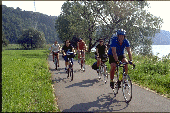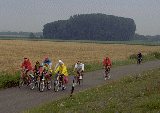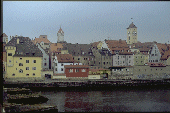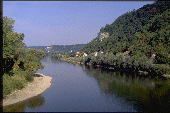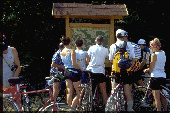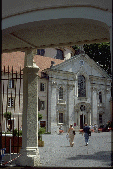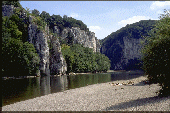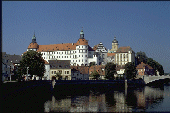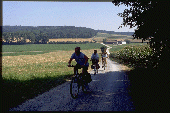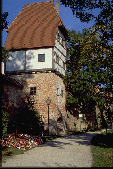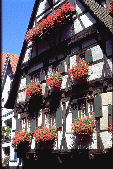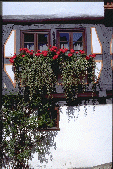|
|
|||||||||||||
|
1998 tour: GERMANY Danube
Passau-Regensburg-Ingolstadt-Donauworth-Ulm-Ehingen-Sigmaringen-Donaueschingen.
Km.: 650 -Days: 8- Month: August
Click on thumbnails to zoom The region you cross when
following the Danube river from Passau on the Austrian border to its sources
in Donaueschingen is not exactly a tourist magnet. And this in a nation,
Germany, which as a tourist destination in Europe faces a rather uphill
struggle against some fearsome competitors such as France, Italy, Spain, and
perhaps others as well... Also from a cycling point of view, this is
indisputably a "granny" tour (except that the German grannies' we
saw rode bikes so loaded we suspected German removers had gone out on
strike). The tour appears to be more frequently done in the direction
opposite to the one we took. We went upriver, which doesn't mean uphill (the
gradient of the Danube course has a negative exponential) but, since the
prevailing direction of winds in the area is from west to east, it's still a
slightly more daring choice ... From any direction, however, this itinerary
offers a wonderful chance to discover a land known to most only through the
very limited point of view of economic indicators, and meet people that,
however reluctant we may be to admit it, are as close an embodiment of the
ideal euro-citizen as we would ever like to be. We start off in Passau,
a town which displays its many baroque jewels on the slopes overlooking the confluence
of three rivers, the Danube, the Inn, and the Ilz, (this last
hardly worth mentioning if it wasn't necessary to complete the symbol-heavy
triad). Passau offers some particularly impressive views as you leave it,
except that when you do that in the morning heading west, you have the sun
right in your eyes. You can risk temporary blindness, even if you are in a
hurry, but taking a decent picture may take hours. For those who come from a
northern-european country it will be hardly necessary to mention that in
Germany everybody rides on bike paths. But if you come from Italy, like us,
or France, Spain etc... it will be new. Germany used to be a nation of
tribes. Today cyclists and motorists still form two of the biggest.
I expect they can mingle,
socially, for example. But on the road, the necessity of keeping them separate
appears immediately evident. If anything, there's simply too many of each
sort. As far as traffic is concerned, I imagine the cyclists get the better
end of the deal, but when it comes to road signs, I am not so sure. For us,
it took some time to make sense of them, and in any case they are so small
that it is simply impossible to read them without stopping, which can get
tiresome after a while...(if you want to practice that, pin a postcard to a
post and try reading it while zooming by at 15-20 mph).
We discover very soon that one
of the main attractions of our chosen itinerary lies in the variety of
detours that are possible by departing from it. It looks like every major
scenic cycling path in south Germany is only a turn -right or left- away. The
road that takes us to Regensburg, for example, follows the foothills
of the Bavarian Forest, which, together with the adjacent Boemian Forest,
form a Natural Park stretching to and beyond the Tzech border. Unfortunately
for us, these detours represent just as many temptations that we must resist.
Regensburg is one of the best preserved medieval towns in Germany, having
escaped remarkably unscathed the destructions of the War.
From 1663 onward Regensburg
hosted the Perpetual Diet (it appears that German emperors had discovered
very early the importance of persistence when it came to dieting). They
indulged more freely other appetites. In Regensburg Charles V started
an affair with a lady of the local bourgeoisie, Barbara Bloomberg, who
eventually gave birth to a child. The boy grew up to become the one Don
John of Austria who defeated the Turks at Lepanto. His fellow citizens
erected in his honour the statue that still decorates Zieroldplatz, in
the heart of the old town.
Between Regensburg and
Ingolstadt lies perhaps the most scenic stretch of the Bavarian course of the
Danube. The river follows a meandering path among gently undulating hills
that gradually become more rugged, until they form a series of steep and
narrow (though hardly breathtaking) gorges. Since the Early Middle Ages
hermits and monks took refuge in this secluded place that offered peace and
isolation, as well as shelter from the turmoil of the age (apparently,
barbarian hordes were more easily deterred than modern tourists).
Later on, a monastery was built
on this place, Kloster Weltemburg, which today sustains a daily siege
from hundreds of vacationers. Weltemburg (along, I suspect, with at least a
dozen other abbeys in northern Europe), claims to have been the first place
to brew a new kind of moderately alcoholic beverage obtained from the
fermentation of cereals, known most commonly -but by no means exclusively- as
beer. Arriving here in what must be one of the hottest days in Germany ever,
with temperatures well above 30 C, we find that in any case the consumption
of the beverage in question provides a much more satisfying experience than
the discussion of its origins and related nomenclature. We are also
pleasantly surprised to discover that the monastery has even its own beach on
the banks of the Danube. Our admiration for those medieval monks is, of
course, further increased.
The town of Ingolstadt has
an old town centre, impeccably restored, enclosed by an industrial belt that
announces the big cities lying further to the west. One of the most
impressive monuments is the Maria de Victoria church, built in the
rococo style. This is Baroque country, there's even a baroque cycling
itinerary that at times runs parallel to our tour. We come upon one of its
highlights soon after leaving Ingolstadt: Neuburg-am-Donau, where the
imposing XVI century palace build by the Palatinate Electors dominates the
old citadel perched on a crag overlooking the river. Other stops on the way
to Ulm are Donauworth, where another famous tourist road, the Romantische
Strasse, crosses both the Danube and the Baroque tour paths.
Hochstadt, another citadel
entered through a medieval towered gate. Lauingen, with its
marketplace hemmed in by a series of XVI century houses, the painted facade
of St. Martin Cathedral and the Schimmelturm. The main towns in the
area, however, are Dillingen and Gunzburg. In Gunzburg we
attend a Fest, that most typically German event where people gather to
eat sausages, drink beer, and listen to musicians in lederhosen (the
traditional costume of Bavaria), singing songs that celebrate just how good
the food and drink are (I'm just guessing, since I don't understand German
very much. I may be horribly prejudiced, but for some reason I can't imagine
anyone coming just for the music...).
Like most German cities, Ulm
has undergone extensive reconstructions as a result of the damages suffered
during the war. The vast, modern square that opens in front of the Cathedral,
of which the large but tasteful building that houses the Tourist Office as
well as various temporary exhibitions barely manages to fill one corner, is
telling enough. Ulm, in any case, still preserves plenty of monuments from
its past, first of all, of course, the Cathedral, that has the tallest gothic
spire in the world (it was completed only in the last century, though). The Fishermen's
Quarter is another historical spot, which features some XV and XVI
century timber-framed houses. One of these, the Crooked House, has
earned a spot in the Guinness' Book of Records as the "crookedest hotel
in the world" (it doesn't look so crooked in the picture... I hope it's
not the camera). To complete the list of Ulm's surprisingly numerous note
worthies, the town is also Albert Einstein's own birthplace. And as
everybody knows, according to Einstein the whole universe is basically a
very, very big crooked house.
Just when you thought I was
done with Ulm, I have to mention that it also marks the border between
Bavaria and Baden-Wurtemberg, where the last leg of our tour takes
place. We cycle in the foothills of the Schwabische Alb, a range of
hills adjacent, and very close in appearance, to the perhaps more famous Schwarzwald
(Black Forest) region. For people who love cycling as well as touring,
here is where the call of those sirens becomes irresistible. The road starts
to climb, and we know that by taking just a little detour we could make it
climb even more. Unlike Ulysses, though, we have just ten days, not ten
years, to reach our destination (it was never my intention to put this down
in verses, anyway...) Besides, I would certainly not be the first to wax
lyrically about this region, that at a certain point in the Middle Ages -when
a local dynasty, the Hohenzollern, inherited the crown of the Empire-
came to dominate a large chunk of continental Europe. They built as usual
plenty of abbeys and castles many of which can still be seen in the hills and
valleys around these parts. Particularly impressive, and quite forbidding (it
may just be the overcast sky though, after days of blazing sunshine), is Sigmaringen.
Its interiors are probably less austere, but since there are no visiting
hours for late coming cyclists, all we can do is guess.
From Sigmaringen, in any case,
starts one of the most interesting bits of our tour. This last stretch of the
Danube has been classified as a natural preserve: the Naturpark Obere
Donau. Obere means, of course "upper", as opposed to
lower, Danube. The former being a couple of feet higher than the latter
(which is nevertheless at least a thousand of miles away, "down" in
Hungary and Rumania). Still, as the landscape around here looks vaguely
alpine (at least for us living on the shores of the Mediterranean), "Upper
Danube" doesn't sound as much far-fetched as it should... In fact the
river itself takes up the aspect of a mountain stream, at least for the
transparency of its waters, untroubled, of course, by even the least swirl or
tumble... Steep crags and wooded slopes enclose it, their image reflected by
the placidly flowing waters as in a polished mirror. These idyllic
surroundings host an army of campers, along with a couple of brigades of the Bundeswehr,
who for some reason do not seem to share the enthusiasm of their civilian
neighbours for the great outdoors.
After a while the
narrow gorges open into a larger valley, and in the middle of it appears the
vast bulky mass of Kloster Beuron. I imagine the monks here make beer
too, but in any case they don't make a fuss about it. There's no beach,
either, although it is true that we are "high" in the Upper Danube
here. Beuron Abbey in any case has a rather serious reputation, as far as
abbeys go. Since the beginning of the century it has flourished as a centre
of spirituality and theological and philosophical studies. As this last
observation puts me in a pedantic mode even more than the usual, let's see if
you have been paying attention to what I have written so far: can you name at
least a couple of things that philosophy has in common with beer and bratwurst?
You can't? It's all right, it wasn't
easy..., here it is: both are things Germans have a passion for, and both may
take some serious pedalling to digest. For us to reach the end of our tour
though, there isn't much pedalling left. As a much wider valley appears on
the horizon, we are in sight of Donaueschingen. Now, it may look
strange that the longest river in western Europe should begin in the middle
of a vast plain. It may even look suspicious: in fact, the circular puddle
enclosed by a fountain-like limestone monument situated in the park of the Furstenbergs'
estate (a family with a suitably pompous name and pretensions to match),
isn't the real source of the Danube. The source is still miles away and hundreds
of feet higher in the mountains around. But these country town landlords just
liked the idea of the big river beginning its voyage across Europe from their
backyard..
[Home Page]-|-[ France]-|-[ Ireland]-|-[ Italy]-|-[
Norway]-|-[
Sweden]-|-[ Scotland]-|-[ United States]
|



